Natural Bridge
Arch - Tunnel
A natural arch, bridge or tunnel is a void beneath still standing bedrock, usually of a short extent, and allowing human passage from one end to the other, at least part of the time.
The other entrance/the other side is visible from each side.
A natural arch is an arch of rock formed by erosion (weathering) from the bedrock, mostly wind, rain and frost.
A natural bridge is a bridge of rock typically spanning a ravine or valley and formed by the erosion of a former cave.
A tunnel is a nearly horizontal cave open at both ends, fairly straight and uniform in cross-section.
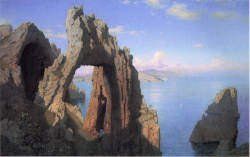
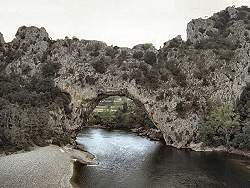
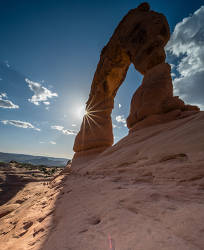
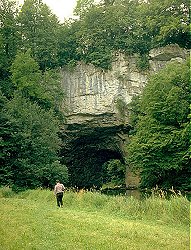
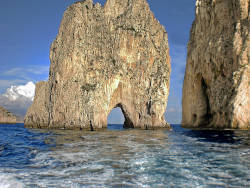
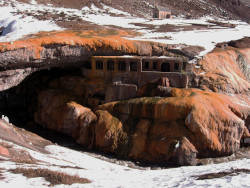
As you can see, this definition is rather vague, which is actually a result of the bandwidth of different forms existing in nature. The definition tries to classify them in a way which is easy to understand and simple to determine. This is rather hard, because there are no numeric, measurable criteria. Even to measure the width, height, and length of an arch can get very complicated. See the link to The Natural Arch and Bridge Society below for more details and examples. And if you read their definitions and then the wikipedia page, you will see that there are numerous different definitions. On showcaves.com we decided to classify above three types as natural bridge. They all must go through a rock or cliff, which means two entrances and a (more or less) horizontal cavern/passage. In other words: you cannot only walk through, you can see the sky on the opposite side.
There are numerous more complicated definitions of the different terms, and there are more specific names like Cliff Wall Arch versus Free-Standing Arch. Unfortunately, these definitions are often contradictory, as can easily be seen in the various proposals to distinguish between natural bridges and arches.
- The National Park Service in the U.S.A. says, bridges were formed by a river, arches by other kinds of weathering.
- A bridge is only a bridge if a road passes over it.
- Natural bridges have a surface that continues into the surroundings, while arches protrude from the surroundings.
- Whether it is called a natural bridge or a rock gate depends on where you are and what has become natural in that region.
We are convinced that the last explanation is the most likely, one should never underestimate how big the influence of traditions is. It’s similar with the term gorge versus canyon. We therefore do not distinguish between the two terms and use them synonymously or as proper names. Nevertheless, there are actually three geological processes creating bridges, a geological difference, based on their formation or genesis. Therefore, natural bridges can be divided into the following three types:
- Natural Bridges that are formed by erosion of the wind or water and can occur in practically any rock
Natural Bridges created by the wind occur mainly in arid and semi-arid climates due to the abrasive effect of the wind’s sand load. Natural Bridges formed by water occur mainly on steep coasts, created by the mechanical weathering of the surf. But they can also be found on valley slopes where they have been created by the erosion of a river. These are the Natural Bridges which are not a karst feature.
Examples are the natural bridges in Arches NP in the USA and the natural bridges on the Great Ocean Road near Melbourne in Australia. - Natural bridges in karst areas are cave ruins
They are formed by the collapse of the cave ceiling in front of and behind the natural bridge and subsequent removal of the debris, e.g. by a cave stream. The surface of the natural bridge continues into the surrounding area and the bridged valley is lower. This second form of a natural bridge, originating from a cave, is a cave ruin, a late form of cave development. Collapses often occur inside large cave passages, usually these collapses result in a dome-like ceiling that deflects the weight of the slope to the sides. Sometimes, however, the cavities are too close to the earth’s surface and the ceiling becomes too thin and collapses. In addition, the removal of rock at the earth’s surface causes subsidence, whereupon the cave ceiling becomes thinner and thinner. Individual collapses of the cave ceiling are called sinkholes or karst windows. As the erosion of the roof progresses, the caves become cave ruins, roofless caves or Collapsed Caves,
different names for the same thing.
When the remains of the cave roof become so short that they resemble a bridge rather than a cave, they are called natural bridges.
These are the Natural Bridges which are a karst feature.
Collapsed Caves,
different names for the same thing.
When the remains of the cave roof become so short that they resemble a bridge rather than a cave, they are called natural bridges.
These are the Natural Bridges which are a karst feature.
Examples on this page are the bridges in Slovenia at Rakov Skocjan, and the Pont du Gard at the Ardeche. - Natural bridges created by deposition
And finally there is a quite rare kind of natural bridge, which is deposited, not eroded. Water depositing limestone, at karst springs with very high limestone content, or at thermal springs, typically builds dams or rimstone pools. But when such a deposit reaches a river, it sometimes grows across the river. As a result, it is possible to cross the river on this natural bridge. There is no erosion involved, the flowing water of the river simply prevents the deposition of limestone in the riverbed.
The most spectacular of these bridges is probably the Puente del Inca in Argentina.
We were forced to paraphrase the three types, in fact there is no technical term for these three types of natural bridges, neither in German nor in English.
- Natural Bridges on showcaves.com
 Malá Pravčická Brána, cz
Malá Pravčická Brána, cz Ponts Naturels à Minerve, fr
Ponts Naturels à Minerve, fr Natural Tunnel, VA, U.S.A.
Natural Tunnel, VA, U.S.A. Pravčická Brána, cz
Pravčická Brána, cz Tianmen Dong, cn
Tianmen Dong, cn Tushuk Tash, cn
Tushuk Tash, cn Arco Naturale, it
Arco Naturale, it Chudnite Mostove, bg
Chudnite Mostove, bg Dyavolski Most, bg
Dyavolski Most, bg I Faraglioni, it
I Faraglioni, it Grand Gulf State Park, MO, U.S.A.
Grand Gulf State Park, MO, U.S.A. Hufangalupe, to
Hufangalupe, to Puente del Inca, ar
Puente del Inca, ar Li’angahuo ’a Maui, to
Li’angahuo ’a Maui, to Needle’s Eye, ID, U.S.A.
Needle’s Eye, ID, U.S.A. Oparara Arch, nz
Oparara Arch, nz Podul Natural de la Ponoarele, ro
Podul Natural de la Ponoarele, ro Puentedey Puente Natural, es
Puentedey Puente Natural, es Rakov Skocjan Nature Reserve, si
Rakov Skocjan Nature Reserve, si Sohoton Natural Bridge, ph
Sohoton Natural Bridge, ph Natural Bridge Springbrook, au
Natural Bridge Springbrook, au Talava Arches, nu
Talava Arches, nu Abercrombie Caves, au
Abercrombie Caves, au Jenolan Caves - Devil’s Coach House, au
Jenolan Caves - Devil’s Coach House, au Natural Bridge Caverns, TX, U.S.A.
Natural Bridge Caverns, TX, U.S.A. Caverns at Natural Bridge, VA, U.S.A.
Caverns at Natural Bridge, VA, U.S.A.
- See also
 Natural arch - Wikipedia (visited: 27-JUL-2023)
Natural arch - Wikipedia (visited: 27-JUL-2023) The Natural Arch and Bridge Society (visited: 27-JUL-2023)
The Natural Arch and Bridge Society (visited: 27-JUL-2023) Types of Arches - Arches National Park (visited: 27-JUL-2023)
Types of Arches - Arches National Park (visited: 27-JUL-2023) Nature’s Arches and Bridges by Galen Berry (visited: 27-JUL-2023)
Nature’s Arches and Bridges by Galen Berry (visited: 27-JUL-2023) 10 Largest Natural Arches in the World | Amusing Planet (visited: 18-SEP-2014)
10 Largest Natural Arches in the World | Amusing Planet (visited: 18-SEP-2014) Natural Arch Information - Frequently Asked Questions (visited: 27-JUL-2023)
Natural Arch Information - Frequently Asked Questions (visited: 27-JUL-2023) Arches UK - a collection of Nature’s arches and bridges (visited: 27-JUL-2023)
Arches UK - a collection of Nature’s arches and bridges (visited: 27-JUL-2023)

 Index
Index Topics
Topics Hierarchical
Hierarchical Countries
Countries Maps
Maps Search
Search